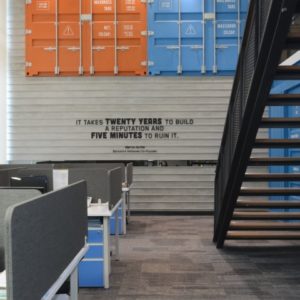

The site, vacant for many years, was formerly an electrical transformer factory. The existing building had layers of character from its past, including a small courtyard tucked behind the warehouse covered in ivy, which became key to the design concept – to extend the experience of the garden inside. This concept interlinked perfectly with the owner’s intention to deliver an experience which was experimental yet simple.
There are two defining elements to the design. THE SHED + THE GARDEN. Low height concrete planter boxes create “plots” of intimate dining spaces. The bold timber-clad shed nestled under the existing pitched roof houses the back of house “tools” of the restaurant. Texture and low-tech simplicity is key to making the new design sit humbly within the existing building. The material palette is a collection of low embodied energy materials, common to the garden. In-situ concrete, recycled timber, mild steel, cyclone wire, raw brass fixtures, cement sheet, outdoor fabrics and an abundance of plants come together to transform the space. Diners eat wholefood vegetarian surrounded by greenery and are reminded with every mouthful of Transformer’s modus operandi, which is quite simply, to honor the seasons.
Instead of walking the mock meat path, vegetables are cast as heroes and each dish is a celebration of vegetables in their prime. The architecture has transformed the space just as the menu transformers the diner without imposing a philosophy. Owners Laki Papadopoulos and Mark Price of Panama Dining, Vegie Bar and Rice Queen have a great understanding of the Fitzroy dining scene and had a strong vision for their new vegetarian venture tucked behind their existing restaurant Vegie Bar on Rose Street, Fitzroy. Similar to Vegie Bar, Transformer offers an all-vegetarian Middle Eastern, Mediterranean and Asian inspired menu, however, it was the client’s intention to create a more sophisticated, refined and experimental restaurant to its sibling next-door.
The key ESD strategies employed were as follows;
• Retain existing building fabric. We retained as much of the existing warehouse as possible. All new interventions are lightweight or freestanding to ensure the building can be easily adapted in the future (given hospitality fit-outs typically have a relatively short lifespan)
• De-materialisation. Strip it back / express it / expose it. Again we enhanced the existing building rather than smothering it with superficial layers. Any materials added were robust, unpretentious and served a purpose.
• Low embodied energy materials. We used a rich and textured pallet of local natural materials wherever possible, including recycled timber (messmate table tops recycled from Geelong station), mild steel door frames & joinery, locally manufactured brass door furniture and tapware, cyclone wire planting screens, no tiles in bathrooms.
• Low energy /high-efficiency fittings All light fittings are long life, dimmable LED lamps
• Low toxicity finishes. Timber surfaces, concrete benches & concrete planter boxes are finished with low VOC finishes
Architects: Breathe Architecture
Design Architect: Jeremy McLeod
Photographs: Peter Clarke








Add to collection










